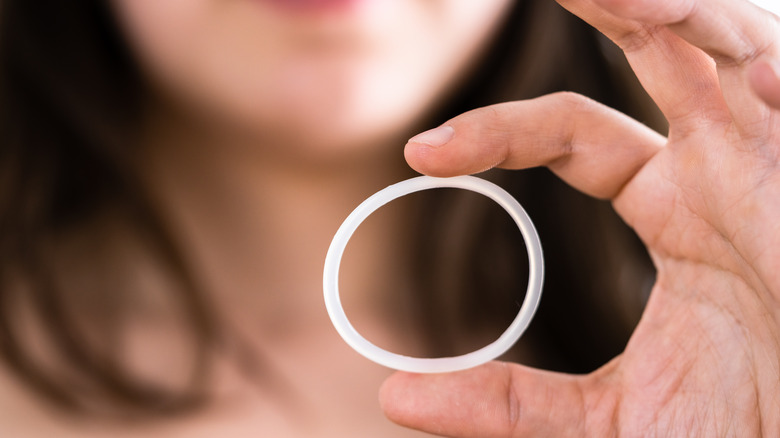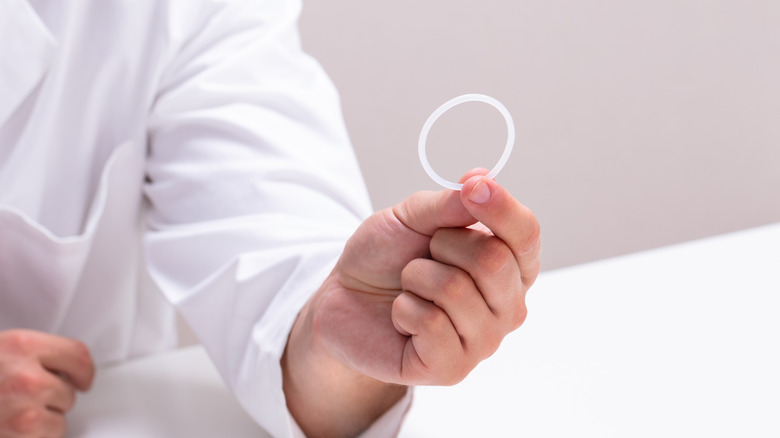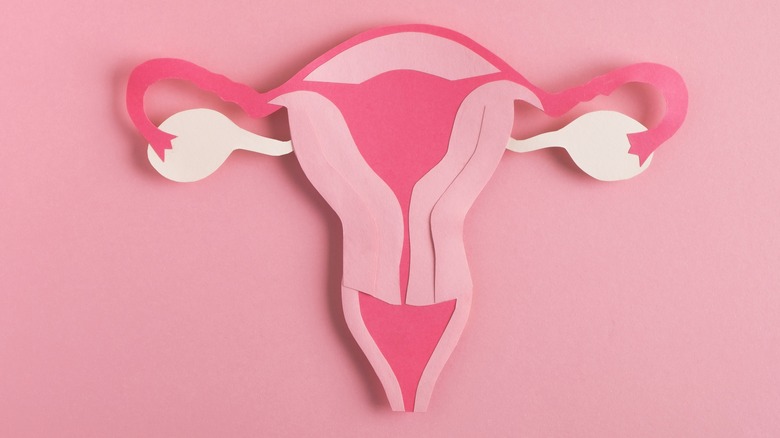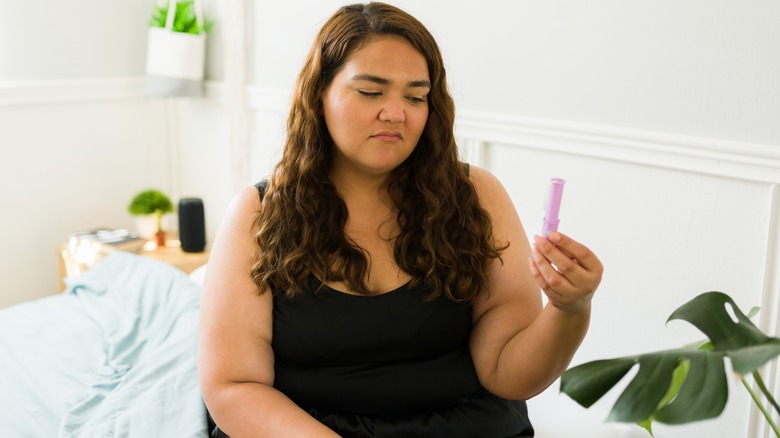11 Things You Should Know Before Using The NuvaRing
Initially approved for use by the U.S. Food and Drug Administration (FDA) in 2001, the NuvaRing is an effective form of hormonal birth control. Otherwise known as the birth control ring, the NuvaRing requires less maintenance than the birth control pill, since it can be left inside the vagina for 3 weeks at a time. It's removed for one week (the fourth week of your cycle) to receive a period (via Planned Parenthood).
According to the NuvaRing website, the ring uses two hormones (estrogen and progestogen) to actively prevent pregnancy. With typical use, it may also help regulate menstrual cycles and lessen cramping or discomfort.
Starting a new birth control can be scary, especially if it's a form that you've never used before. However, the NuvaRing is particularly great for people who want something that's easy to use and can be inserted or removed at home. Read on to learn more about its effectiveness, side effects, who it's best for, and more.
What is the NuvaRing?
The NuvaRing is a safe form of hormonal birth control. As the National Health Service (NHS) explains, it's a small plastic ring that gets inserted into the vagina and releases continuous doses of both estrogen and progestogen. According to Healthline, it's lightweight and flexible and, when used as directed, can be up to 99% effective at preventing pregnancy. It does not, however, prevent the spread of sexually transmitted infections (STIs).
NuvaRing differs slightly from intrauterine devices (IUDs) since it's taken out every 3 weeks. You keep it in your vagina for 21 days, then remove it for the next 7 days, as stated by NuvaRing's website. You should get your period during that week, but there are ways to use the NuvaRing to safely prevent getting a period. Meanwhile, IUDs are kept in the vagina and can last up to 10 years (per the NHS), while birth control pills are taken daily at the same time for 21 days, after which a 7-day break follows (via the NHS).
How the NuvaRing works
The hormones found in NuvaRing are the same ones found in the birth control pill. Healthline states that NuvaRing contains 0.015 milligrams of ethinyl estradiol and 0.12 milligrams of etonogestrel (which are derived from estrogen and progestogen) per 24 hours. These synthetic hormones help prevent pregnancy by contacting the vagina, then getting absorbed and flowing into your bloodstream (via Gulf Coast Obstetrics and Gynecology).
NuvaRing prevents pregnancy by preventing the release of an egg each month and thickening the cervical mucus, making it more difficult for sperm to move through, as stated by the National Health Service.
After the 7-day break, you should insert a new NuvaRing for another 21 days. According to the NuvaRing website, you should make sure that you're inserting and removing it at the same time (for example, if you put it in on Tuesday at 10 a.m., it should be taken out 3 weeks later on Tuesday at 10 a.m.). NuvaRing manufacturers also recommended that you insert the new ring exactly a week later after your fourth week (or your period week), even if you haven't stopped bleeding yet.
Who the NuvaRing is for
The NuvaRing is a great form of hormonal birth control for many types of people. For some, remembering to take a pill at the same time every day is bothersome, especially if they have particularly busy lifestyles. In the case of the ring, all you have to do is remember to take it out and put in a new one in, though you'll want to make sure you're doing so on the same day. The NuvaRing is also good for people who want to get a period. It's typical for periods to lighten or completely go away on some types of birth control, but you should still get a period on NuvaRing (via the NuvaRing website).
NuvaRing is also a good option for people who want something less permanent than an IUD. Certain IUDs, like Paragard, can last for up to 12 to 20 years, according to Bedsider. IUDs can be removed at any point and fertility can continue almost immediately after removal (via Healthline). Meanwhile, Planned Parenthood states that if you leave your NuvaRing out for more than 2 days after you're supposed to have it in, you will no longer be protected from getting pregnant. If you remove your NuvaRing and want to get pregnant, WebMD says that it'll most likely take a few weeks. Because of this, if you want to get pregnant at a certain point and elongate the process of conceiving, the NuvaRing may be a good choice.
Who shouldn't get the NuvaRing
Some groups of people probably shouldn't get the NuvaRing, though that choice will ultimately be up to you and your doctor. However, according to WebMD, the NuvaRing shouldn't be used if you have a history of blood clots, stroke, or heart attack; are pregnant; have hormone-sensitive cancers; are over 35 years of age and a smoker; have liver disease, or have uncontrolled high blood pressure. In addition to that, the site states that people who experience migraine should talk to their doctor before making a decision to get the NuvaRing.
The NuvaRing website warns users that anyone who is allergic or intolerant to etonogestrel, ethinyl estradiol, or any other active ingredients in the birth control ring shouldn't use it. Additionally, if you've ever experienced jaundice caused by pregnancy or related to use of other hormonal birth controls, NuvaRing may not be the best choice for you.
How to get the NuvaRing
After you've made the personal decision to get the NuvaRing, you should make an appointment with OB-GYN to discuss your medical history and birth control goals if they extend beyond preventing pregnancy. Should you choose to move forward with getting it, your doctor will likely write a prescription for the birth control ring. According to Planned Parenthood, it's not always necessary to have a pelvic exam to receive NuvaRing, but you may still get one. One NuvaRing can cost anywhere from $0 to $200, depending on your insurance coverage. If you have health insurance, there's a good chance that you'll receive it for free or a low co-pay.
Once you've picked up your prescription, you should insert the NuvaRing. The website instructs users to wash and dry your hands, then remove it from the foil pouch. You can insert it while lying down, squatting, or standing with one leg up, depending on what position you're most comfortable in. From there, you should hold the ring between your thumb and index finger, press the sides together, and gently push it into your vagina. If it feels uncomfortable, you may need to push it in further.
NuvaRing effectiveness
NuvaRing's effectiveness depends on how it's used. Generally, though, a 2010 study found that pregnancy rates are pretty low with the birth control ring (via the International Journal of Women's Health).
With perfect use (this is when it's used 100% as instructed and every time you have sex), Bedsider states that it's 99.7% effective. Typical use — or people who use the birth control ring on a "typical" basis, with mistakes accounted for — finds that NuvaRing is still about 93% effective.
Healthline notes that the best way to make sure the NuvaRing is as effective as possible is inserting and removing the ring on the same day of the week. You should also use backup contraception (like a condom or spermicide) if the ring has been out for more than 3 hours, or if you take any medications or supplements that may interact with it.
Ultimately, when compared to other forms of hormonal birth control like the pill or IUD, NuvaRing is just as effective (as stated by the National Health Service).
NuvaRing side effects
Most forms of birth control come with a long list of side effects, but many are less likely to occur than others. As explained by Drugs.com, NuvaRing side effects that require medical attention include symptoms of overdose, menstrual changes, nausea, and vaginal bleeding. Side effects that should be discussed with your doctor may include blurred vision, constipation or diarrhea, headache, nausea, vomiting, and slow or fast heartbeat.
WebMD also states that vaginal discomfort or irritation, bloating, breast tenderness, spotting, and weight change may occur, especially during the first few months of use. These aren't necessarily symptoms to be extremely concerned about, but if they become increasingly uncomfortable or persist, you should make an appointment to speak with your OB-GYN.
Lawsuits have been filed against NuvaRing for injuries and deaths from blood clots, heart attacks, and strokes that have been allegedly caused by the ring (via Drugwatch). These side effects are relatively rare, though.
Benefits of the NuvaRing
There are many benefits to using the NuvaRing as a form of birth control. For one, it's highly effective. According to Florida State University Health Services, it can also help regulate menstrual cycles and possibly reduce cramping, blood loss during periods, iron deficiency, and your risk of ovarian and endometrial cancers.
Otherwise, WebMD states that the birth control ring is also easy to use, safe, and private. Since it's already been inserted before having sex, you don't have to stop to insert or put anything on. Additionally, you don't have to worry about it every day. As long as it's inserted as soon as you receive it, it begins working immediately, via Medical News Today.
Planned Parenthood also notes that there are some health benefits to the NuvaRing. It can help prevent or lessen acne, premenstrual syndrome (PMS), cysts in your breasts and ovaries, and bone thinning.
Myths about the NuvaRing
That being said, like many other hormonal birth controls, there are myths surrounding insertion and possible side effects. Primarily, it's important to know that NuvaRing doesn't protect any partners from STIs (via Medical News Today), even though it's inserted into the vagina. Barrier methods, like internal (female) condoms or male condoms, are the only forms of birth control that can help stop the spread of certain STIs (as stated by WebMD).
It's also a common misconception that you can't use a tampon or menstrual cup with the NuvaRing. Healthline notes that it's 100% safe to do so and won't make the NuvaRing any less effective. You should, however, be careful about accidentally moving the NuvaRing when inserting or taking out a tampon. Additionally, the NuvaRing can't get lost inside of you, but there have been some rare cases where it's accidentally been inserted into the bladder (via Healthline).
Having sex with the NuvaRing
According to Planned Parenthood, the birth control ring is both soft and flexible due to the material it's made of. If it's inserted properly, you or any sexual partners shouldn't be able to feel it.
Healthline states that you can remove the NuvaRing up to 3 hours before sex, but you shouldn't do this more than once in a 24-hour period. Planned Parenthood recommends rinsing it in lukewarm water and putting it back in as soon as you're done having sex. The site also advises against using oil- or silicone-based lube with the NuvaRing (water-based lubes are fine). If you leave the NuvaRing out for more than 2 days during the weeks that you're supposed to be wearing it, you won't be protected from pregnancy, and should use backup forms of contraception.
Should you experience difficulty with insertion or your partner repeatedly feels it during sex, you may want to make an appointment to see your OB-GYN. They may be able to help you with any issues that you're having and teach you how to correctly insert it.
How to remove the NuvaRing
You'll have to remove the ring every 3 weeks after insertion on the same day of the week, according to the NuvaRing website. To properly remove it, you can get in the same position you use to insert it (or any other comfortable position), put your index finger into your vagina, and hook it through the NuvaRing. From there, you should gently pull down and forward to take it out. After that, you should throw away the used NuvaRing in the foil packaging. It shouldn't be flushed down the toilet.
If you forget to remove your NuvaRing, you should keep it in place for the entirety of week four, as stated by Verywell Health. On day one of your next 28-day cycle, you should take it out, wait 7 days to insert a new one, and use a backup form of contraception (like condoms or spermicide) for the first week after inserting the new NuvaRing.












